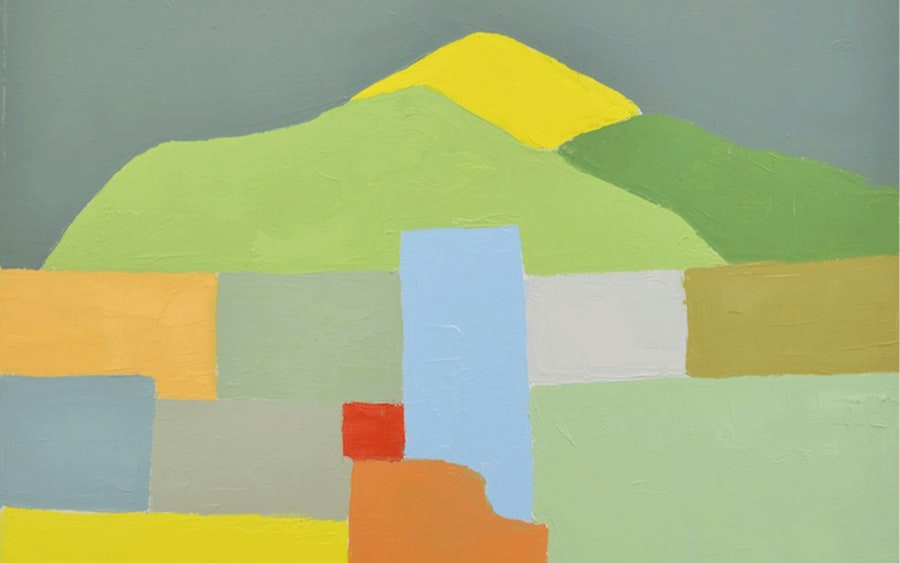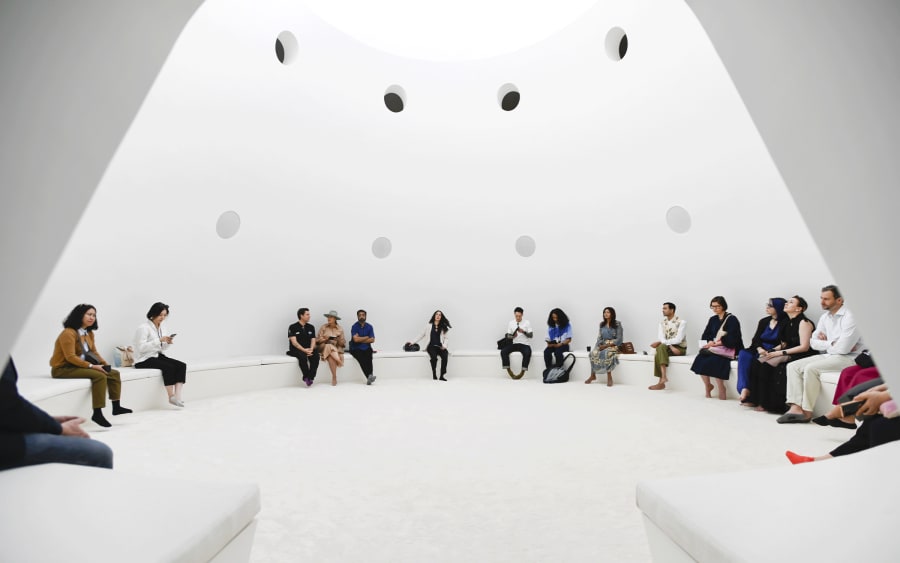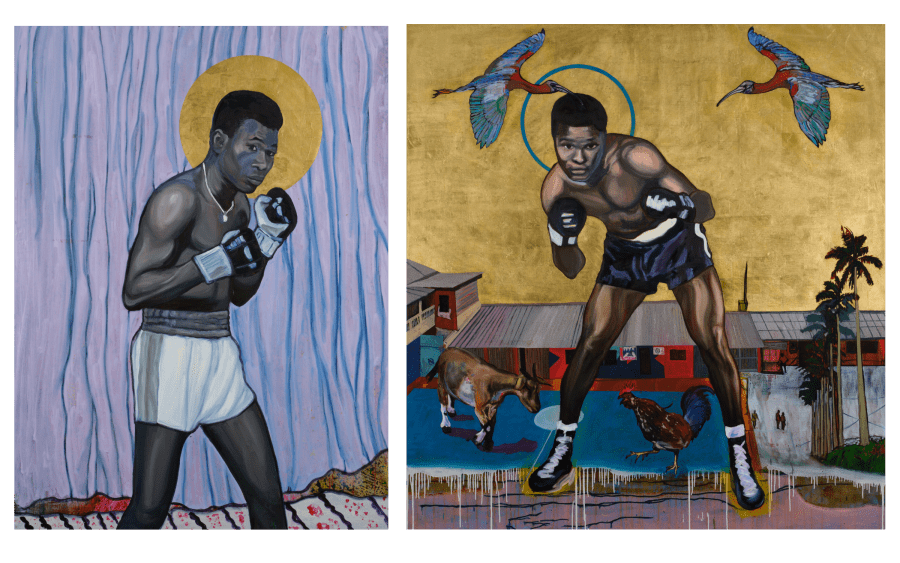A little-known fact about Ute Meta Bauer is that, before she became a world-renowned educator and curator, she trained as an artist at the Academy of Fine Arts in Hamburg, Germany. And today, she says she learned everything about curating from working closely with artists. ‘I’m not an art historian, but I understand what an exhibition can do,’ she tells me days before the opening of the Diriyah Contemporary Art Biennale 2024 in Saudi Arabia. ‘At documenta and the Venice Biennale, it’s usually younger artists who work as installers. This is how you learn how works act in space. Although I started several curatorial programs, practice cannot be taught, it needs to be practiced.’
Bauer has spent a decade as the founding director of the NTU Centre for Contemporary Art Singapore and much longer working as an independent curator, notably on the late Okwui Enwezor’s documenta11 (2002), followed by two Venice pavilions (the American in 2015, and the Singapore pavilion in 2022). As Artistic Director of the Diriyah Contemporary Art Biennale’s latest edition, entitled ‘After Rain’, she leads a curatorial team which has assembled 177 works by 100 artists, with the majority of the 47 new commissions emerging from the wider Gulf region.
Bauer first visited Saudi Arabia five years ago, and for this show – which investigates how built and cultural environments unfold complex histories – she is again listening to cues from artists. For Art Basel, she highlighted some who should be on everyone’s radar.
Sara Abdu
b. 1993, Jeddah, Saudi Arabia, where she lives and works
‘Sara Abdu is one of the first artists I invited. I met her in Jeddah in 2018 and I kept in touch. For me it is always good to see the conditions in which a younger generation of artists are developing. For the biennale, Abdu has created a new installation entitled, Now That I’ve Lost You in My Dreams, Where Do We Meet? (2023), with both an olfactory and sculptural component. With handcrafted soaps forming three towers, it deals with tactility and the materialization of absence through sound. Her soaps, infused with sidr and camphor, took a good year to produce with different molds and titular inscriptions on each. They reference cleansing rituals that prepare corpses for burial. Inspired by her grandmother, the work grapples with that which is no longer present. It presents a complicated relationship to history and how we remember. It also sparked debate around showing a work about a private moment in a biennale, but we want to have these longer conversations about how the cultural environment impacts young Saudi artists and what they want to highlight about this transformative moment.’
Azra Akšamija
b. 1976 in Sarajevo, lives and works in Boston, MA
‘I met Azra Akšamija in 2005, when I was a professor at MIT and she was a PhD student. Originally from Sarajevo, she is both an Aga Khan award-winning architect, a practicing artist, and a scholar, who studies the cultural canons around mosques in different contexts. I was intrigued by her notion of the “wearable” mosque as an orientation, and not just a building, and the view that the smallest mosque could be the prayer mat. Her commissioned installation for the biennale, Abundance & Scarcity (2024), incorporates recycled felt previously used in the scenography of Diriyah’s Islamic Art Biennale in 2023, now employed to create sunshades, and which will in turn be repurposed for refugee camps in Jordan. Sustainability is a big part of Akšamija’s practice as an architect. For this work, she has created a sheltered 70-meter-long passageway with patterns inspired by Al Sadu weaving techniques [made by Bedouin women] in the Najd region of Saudi Arabia. Such motifs are an important part of the architectural vocabulary here. When you walk underneath the patterns, you see shadows cast by the sun. I’m interested in the kind of discourses that will unfold with the work and what we can learn about a place without reproducing a cliché.’
Camille Zakharia
b. 1962 in Tripoli, Lebanon, lives and works in Manama
‘Camille Zakharia was recommended by my cocurator Wejdan Reda. I was stunned by the richness of his library and his interest in architectural typologies, and how he sees the photographic gaze as a time capsule — a container of heritage. He and I share a love for photographers such as William Eggleston and August Sander. His new commission, The Mountain My Neighbor (2024), is based on observations of families who have built new townhouses into the rocks, which he noticed on the drive from Riyadh airport. It’s a shifting landscape in which a rock becomes architecture – these houses deploy a vernacular tradition, but in concrete. Zakharia understands that the ownership of a plot of land by families is more about imagining home than about real estate development. I’m showing his newly commissioned series together with older works from the Al Bar (2010-2016) and Coastal Promenade (2010) series taken in an abandoned fishing village and seaside hubs in Manama, where many Saudis visit seasonally from Dammam. Juxtaposing these architectures leads to questions on their cultural function in relation to the landscape.’
Ahmed Mater in collaboration with Armin Linke
Ahmed Mater, b. 1979 in Tabuk, Saudi Arabia, lives and works in Riyadh
Armin Linke, b. 1966 in Milan, Italy, lives and works in Berlin
‘Saudi artist Ahmed Mater and Italian-born photographer Armin Linke have collaborated on a work called Saudi Futurism (2024), an installation on changing infrastructures and future visions. It begins when cement was introduced in the 1940s and features iconic architects such as Frei Otto who began to build here in the 1980s. I know this context well because some of the architects were from Stuttgart, my hometown, and my friends were their students. Mater and Linke have also photographed some landmarks: Saudi’s space agency and parts of the megacity, NEOM. The project implies a longer-term investigation into who constructs this vision of the future and how it is fabricated.
Mater, who has carried out in-depth research on Makkah, has an incredible archive and Linke has long documented post-industrial development and science labs. I am interested in the ways in which artists become archivists and historians. Everyone is fascinated by William Turner’s skies, but these happened when Mount Tambora erupted in Indonesia. What does an artist’s sensibility contribute to our understanding of the world?’
Abdulrahman Al-Soliman
b. 1954 in Al-Ahsa, Saudi Arabia, lives and works in Dammam, Saudi Arabia
‘It’s difficult to pick just one Saudi modernist because we also have great female pioneers, like Nabila Al Bassam and Safeya Binzagr. But when we visited Al-Soliman, he had a stack of ink drawings under some books that caught my eye. The series, Palm, Bow, and Fragments (1990-1991) is a selection of 56 depictions of the sky he made during the first Gulf War. He describes how planes would fly over his studio in Dammam, en route to Kuwait, and how he couldn’t paint at the time. For me, it was when CNN started to report on the war, and ironically, the beginnings of live coverage after midnight in Germany.
Al-Soliman is part of a whole generation of artists that has been very active but are still underrepresented. We have dedicated a hall to them, and not just Saudis: Rasheed Araeen has early portraits made in Karachi, which we juxtapose with Safeya Binzagr’s drawings of tribal clothing. We do not want to just look into the future without carving out the time and space to consider this body of work in the present. A biennale is always a provocation; I hope we can make some of these debates visible.’
Nadine Khalil is an independent art critic, editor, and curator based in Dubai. She edited The Arts Center: Building a Performing Arts Community on Saadiyat Island (2023) and contributed to Evaporating Suns: Contemporary Myths from the Arabian Gulf (2023). Her writing can be found in Art Agenda, artnet, Art Review Asia, Brooklyn Rail, Financial Times, Frieze and Ocula.
Diriyah Contemporary Art Biennale
‘After Rain’
February 20 - May 24, 2024
Full-bleed image: Portrait Ute Meta Bauer. Photo by Christine Fenzl.
Published on February 20, 2024.


